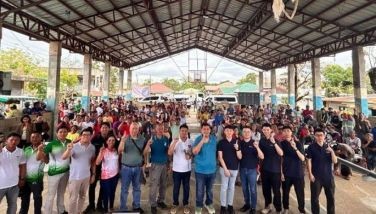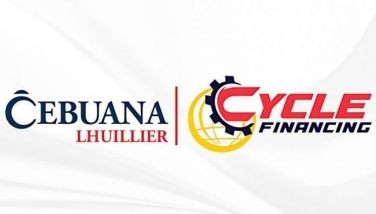Inconclusive

April 12, 2007 | 12:00am
 Are dissimilarities found between the questioned signature and the genuine one decisive as to the forgery of the questioned signature? This is one of the issues raised in this case between Patricio and his co-owners versus Lita and her children.
Are dissimilarities found between the questioned signature and the genuine one decisive as to the forgery of the questioned signature? This is one of the issues raised in this case between Patricio and his co-owners versus Lita and her children.
The case involved a parcel of land with an area of 5,795 square meters previously covered by TCT No. 3444. Patricio and all the successors-in-interest of Nena, already deceased, were the co-owners, co-heirs and/or descendants of the original owners of said land. Sometime in 1992 when Patricio and his co-owners allegedly decided to partition the said land, they discovered that its title was already in the name of Lita, a widow and her children (TCT No. 8585) by virtue of a Deed of Sale dated December 30, 1967 purportedly executed by Patricio, Nena and the predecessors-in-interest of the other co-owners. Thus on September 19, 1996 or more than 29 years after the execution of the Deed of Sale Patricio et. al., filed a complaint against Lita and her children for declaration of its nullity, cancellation of TCT 8585 and all subsequent documents plus damages. They alleged that the Deed was a forgery as Patricio and the other co-owners did not sign the conveying deed nor receive any consideration therefor, and that one of the alleged vendors, Nena, had already passed away in 1960 long before the execution of the purported Deed of Sale in 1967.
Lita and her children denied the material allegations of the complaint. They averred that Lita and her late husband bought the said land from its previous owners on December 12, 1967 as evidenced by the Deed of Sale duly notarized by a certain Atty. Rodolfo Yap. They further asserted that they had been in open, continuous and peaceful possession of the land in question from the time of said sale and had been religiously paying the realty taxes due thereon. By way of affirmative defense, they further asserted that Patricio et.al’s cause of action had already prescribed in view of the unreasonable delay in filing the suit in court let alone the fact that their title had become indefeasible.
During the trial, Patricio again denied that he signed the said deed. But they failed to present a handwriting expert to determine whether there was indeed forgery although they filed motions in the trial court to have the original copy of the Deed and their own special power of attorney containing the genuine signatures of their predecessors-in-interest be examined by a handwriting expert. They asked the lower court to issue an order requiring a handwriting expert to appear before it and compare these documents. However, the lower court denied their motions on the ground that it behooves upon the parties themselves to call forth their own witnesses and present their own evidence to bolster their respective claims. Hence, since Patricio et.al. failed to present their own expert witness apart from their self-serving allegations, the trial court came out with its decision finding that their evidence was insufficient to establish their claim of forgery.
Patricio and his co-plaintiffs questioned this decision. They maintained that by merely examining the signatures in the questioned Deed and the genuine signatures of their predecessors-in-interest in their Special Power of Attorney, the glaring dissimilarities between the two sets of signatures are immediately evident to support their claim of forgery. Were they correct?
No. The authenticity of a questioned signature cannot be determined solely upon its general characteristics, similarities or dissimilarities with the genuine signature. Dissimilarities as regards spontaneity, rhythm, pressure of the pen, loops in the strokes, signs of stops, shades, etc., that may be found between the questioned signatures and the genuine ones are not decisive on the authenticity of the questioned signatures. The result of examinations of questioned handwriting even with the benefit of the aid of experts and scientific instruments is, at best, inconclusive. Other factors must be taken into consideration. The position of the writer, the condition of the surface on which the paper is based when the questioned signature is written, his state of mind, feelings and nerves, and the kind of pen and/or paper used, play an important role on the general appearance of the signature. Unless therefore, there is, in a given case, absolute absence or manifest dearth of direct or circumstantial competent evidence on the character of the questioned handwriting, much weight should not be given to characteristic similarities or dissimilarities between the questioned handwriting and an authentic one.
The process of identification therefore, must include the determination of the extent, kind and significance of the resemblance as well as of the variation. It then becomes necessary to determine whether the variation is due to the operation of a different personality, or is only the expected and inevitable variation found in the genuine handwriting of the same writer. It is also necessary to decide whether the resemblance is the result of a more or less skillful imitation, or is the habitual and characteristic resemblance that naturally appears in a genuine handwriting. The answers to these two questions solve the whole problem of identification. In the present case all that Patricio et.al., had to offer by way of evidence on the issue of forgery was their bare denial that their predecessors-in-interest signed the subject Deed of Sale. Such denial will not suffice to overcome the presumption of regularity of notarized documents, to overthrow which, the countervailing evidence must be clear, convincing and more than merely preponderant (Tapuroc, et.al., vs. Vda de Mende et.al., G.R. 152007, January 22, 2007).
BrandSpace Articles
<
>
- Latest
- Trending
Trending
Latest
Trending
Latest
Recommended

























